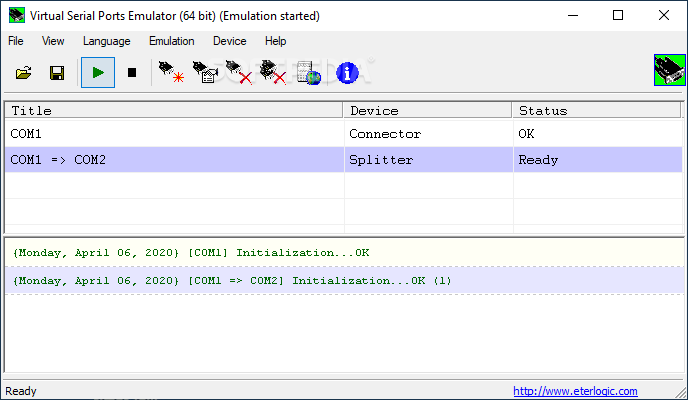Serial Port Emulator
This module has a full integrated Linux OS, so it's happy to respond on its mini-USB port, to PuTTY/Telnet type connection requests and offers a full account security capability etc.
I'd like to connect my laptop (running Win XP SP3 32-bit) to this module, using a USB port in my laptop with a cable that has a mini-USB port on one end, and a normal USB connector on the other end.
What I want to ask about is what do I need, in terms of software or device drivers, to make this happen?
Here's a crude diagram of what I'm trying to connect together:
[MODULE with RS-232 connection using mini-USB port] <-------- Mini-USB connector -- CABLE -- Normal USB connector --------> [Laptop with USB port]
Will it work straight away or do I need some kind of Serial-over-USB device driver/emulator software or other software that will allow my USB port (on my laptop) to 'act' as a serial port and connect to the module's mini-USB?
Employing virtual devices to simulate the behavior of their physical counterparts has long been a widely accepted method of developing, testing and debugging software.


Serial port emulation is used by developers of complex serial communication systems. Programmers can use a variety of software tools that provide operating systems (primarily Windows OS) with virtual serial ports. These software solutions allow testing and monitoring of serial port communications between RS232 and RS484 interfaces.
Even applications designed to work with hardware COM ports that are resident on client computers can be tested without connecting to physical serial ports, Dedicated software tools enable the creation of pairs of virtual COM ports that communicate by way of a virtual null-modem cable. You can also develop a serial port emulator yourself to simplify the testing and monitoring of data traffic between your program and a physical COM port.
Serial port emulation: main principles
- Programmers can use multiple virtual serial ports, allowing them to diagnose and debug software on systems containing no physical serial ports.
As an example, consider that a programmer developing and debugging an application for serial communication will usually need at least two physical serial ports. Currently, most computers provide at most one serial port, forcing a developer to either use two machines or obtain a PCI card containing a COM port. By using the serial port emulator the programmer can now create multiple virtual COM ports on one computer, allowing any serial communication program to be developed on any computer that can run the emulator.
By emulating COM ports, developers no longer need to use complex software to control interprocess communication and the sharing of physical resources. The speed of data transmission is not dependent on the physical COM port but relies on your system specifications as traffic moves between the virtual ports.
Virtual serial ports can replicate all the parameters of physical serial ports and provides strict baudrate emulation.
Virtual COM Port Driver by Eltima Software is a powerful serial port emulator that offers advanced functionality built on a simple, user-friendly interface. All recent versions of the Windows operating system are supported by VSPD. The tool is even more stable when run on Windows 10 as it is digitally signed with WHQL. These are just a few of the many reasons that make Virtual Serial Port Driver one of the best and effective serial port emulate tools available.
Serial port simulation with different programming languages
To simplify working with files and devices, standard options such as CreatePair, DeletPair, SetStrictBaudrate and others are fully supported by VSPD. Below are some examples of how you can take advantage of Virtual Serial Port Driver with some popular programming languages.
C/C++
Load the DLL file dynamically and then choose and call your desired functions to effectively use virtual port emulator. Here’s how it looks in Visual C++ :
Visual Basic

With Visual Basic, you need to paste these lines into your source file to access the functionality of VSPD:
With the VSPDCTL.DLL in your application’s directory, the functions can be called directly.
Delphi
Here are the function declarations for Delphi:
ArmAccess can be loaded statically or dynamically. For dynamic loading, use this sample code: